Have you ever found yourself captivated by a fictional character’s every move, hanging on their every word, unable to tear yourself away from their story? One thing that makes these characters so compelling is their mannerisms—those unique quirks and tics that make them stand out from the crowd and bring them to life on the page. Whether it’s a nervous habit or a distinctive physical gesture, these traits make your characters seem more human and relatable, and can help build a powerful emotional connection between reader and protagonist.
In this guide, we’ll explore over 400 different mannerisms that can take your characters from ordinary to outstanding, and help you craft stories that will keep your readers on the edge of their seats.
What Are Character Mannerisms?
Character mannerisms are specific physical or behavioral traits that a character exhibits consistently throughout a story. These mannerisms can range from subtle gestures, such as tapping a foot or twirling their hair, to more prominent actions, like constantly swearing or speaking in a distinct dialect.
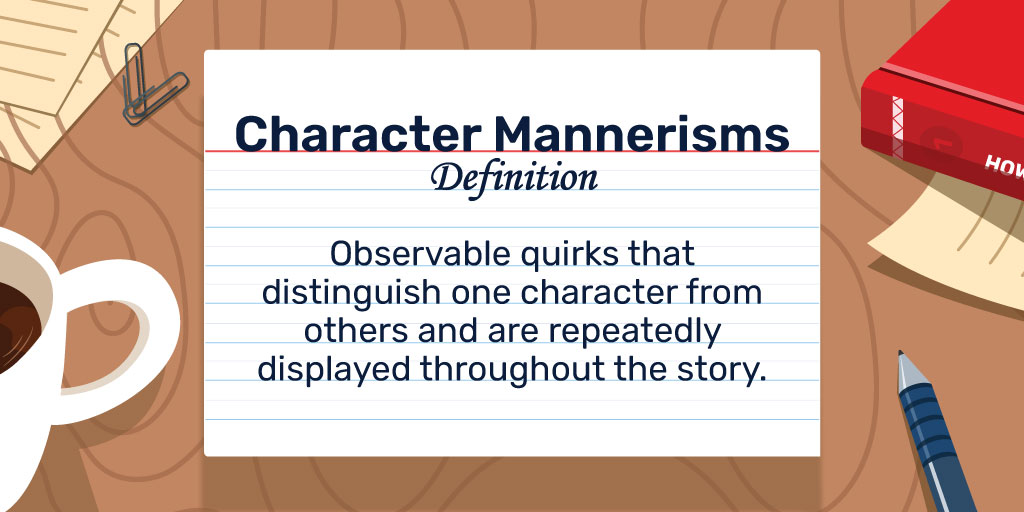
It is useful to distinguish mannerisms from personality traits or emotions. While mannerisms are easily observable behaviors that are exhibited repeatedly, personality traits and emotions aren’t always visible to observers. Moreover, traits and feelings are so broad that they don’t manifest in the same way quite as often, and are thus not as repetitive.
Look at this overview for an illustration of the difference:
Mannerism | Trait/Emotion |
|---|---|
Nail biting | Nervousness or boredom |
Constantly interrupting others’ speech | Arrogance or lack of patience or empathy |
Checking phone frequently | Anxiety, addiction, or need for connection |
Avoiding eye contact | Shyness, insecurity, or dishonesty |
Using hand gestures while speaking | Confidence or passion |
Frequently adjusting clothing | Self-consciousness, discomfort, or need for perfection |
Overusing the word “like” | Informality, hesitation, or lack of clarity |
Standing too close to others | Aggressiveness, need for connection, or lack of boundaries |
As you can see, mannerisms often indicate personality traits or emotions. But traits and feelings are so broad, complex, and expressible in different ways that they aren’t as repetitive and observable.
Importance of Character Mannerisms
Character mannerisms allow authors to develop more likeable characters that will keep readers interested in their stories. Here are some of the specific ways in which mannerisms add value to stories:
- Memorability: They help to make a character more vivid and memorable, allowing readers to better picture and relate to them.
- Depth: Mannerisms can reveal deeper aspects of a character’s personality and their motivations, providing insights into their thoughts and feelings that might not be obvious through their actions or dialogue alone.
- Realism: Because mannerisms are present in real life, they can create a sense of authenticity and realism within the story world, making it feel more immersive and believable.
- Uniqueness: A character can be distinguished from another by their mannerisms, which helps readers keep track of the various fictional people and the connections between them.
- Show, don’t tell: They allow writers to show a character’s thoughts and feelings instead of telling the readers what they are thinking and feeling.
Examples of Character Mannerisms
Let’s look at three examples of unforgettable mannerisms from recent fiction to illustrate the main categories of physical, vocal, and behavioral mannerisms:
- In Sally Rooney’s Normal People the character Marianne frequently tucks her hair behind her ears, which is a physical mannerism used to reveal her shyness and insecurity, as well as her desire to appear neat and put-together.
- As an example of a vocal mannerism, the character Baby Suggs in Toni Morrison’s Beloved has a habit of speaking in poetic language, using imagery and metaphor to convey her thoughts and feelings. This reflects her spiritual nature and her connection to nature and the divine.
- The character Elwood, who appears in Colson Whitehead’s The Nickel Boys, often recites passages from Martin Luther King Jr.’s speeches as a way to ground himself and find inspiration in difficult situations. This behavioral mannerism reveals his idealism and his commitment to social justice, even in the face of extreme adversity.
Character Development Quiz (Easy)
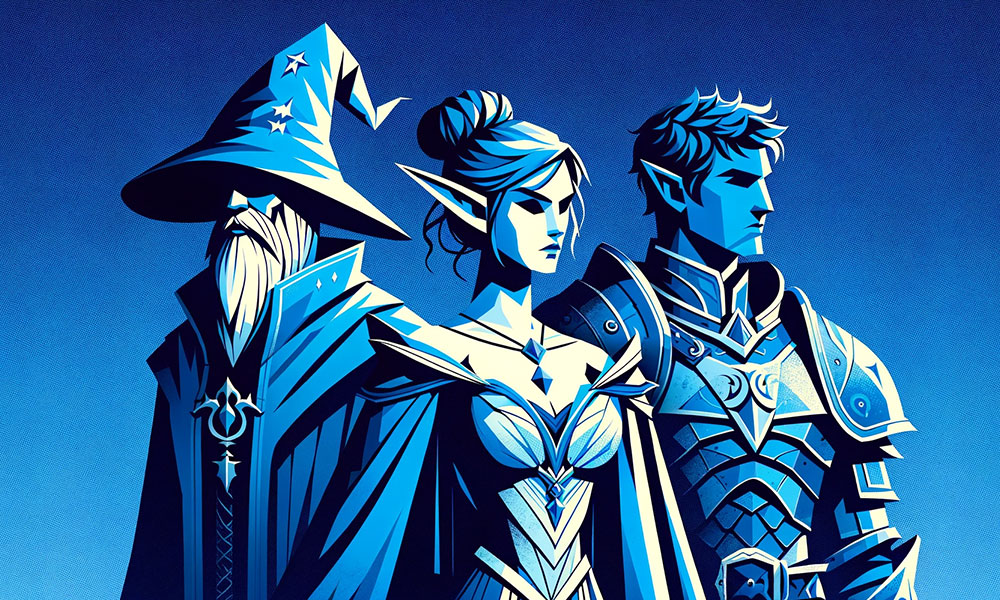
Ultimate List of Character Mannerisms
We have compiled a comprehensive list of over 400 powerful quirks and tics that you can use to create outstanding characters in your stories. Whether you’re writing a novel, a screenplay, or a short story, this list can help you add depth, nuance, and authenticity to your characters and make them truly unforgettable.
Mannerisms can be roughly divided into three main categories:
So, without further ado, let’s dive into the big list and discover the perfect quirks for your characters.
Physical Mannerisms
Physical mannerisms are bodily actions that a character displays, primarily by using their own bodies. These include things like gestures, facial expressions, postures, and movements such as tapping a foot or running a hand through their hair.
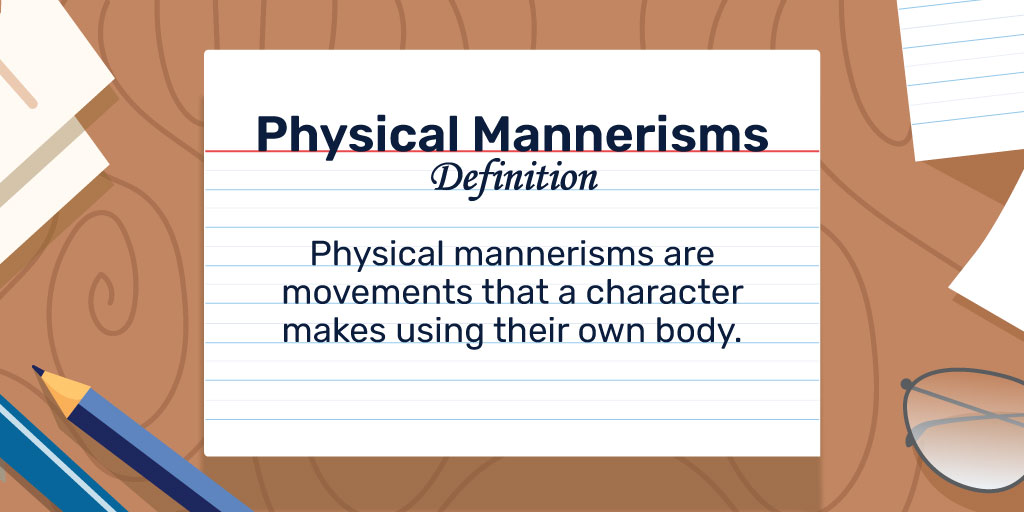
Facial Expressions
- Biting the inside of the cheek
- Biting the lower lip
- Clenching the jaw
- Curling the lips
- Flaring the nostrils
- Fluttering the eyelashes
- Frowning
- Furrowing the brow
- Grimacing
- Gritting the teeth
- Jutting out the chin
- Licking the lips
- Pouting
- Pressing lips together
- Puckering the lips
- Puffing the cheeks
- Quivering chin
- Raising one eyebrow
- Scowling
- Scrunching the nose
- Smiling
- Smiling with closed lips
- Smiling with just one side of the mouth
- Smirking
- Snarling
- Sticking out the tongue
- Sucking the teeth
- Sweating excessively
- Talking from a corner of the mouth
- Tightening the jaw
- Tightening the lips
Eye Movements
- Avoiding eye contact
- Blinking rhythmically
- Blinking slowly
- Darting eyes
- Eye-rolling
- Flicking the eyes up and down
- Focusing on one point
- Gazing into the distance
- Glancing sideways
- Glassy eyes
- Half-closing the eyes
- Looking down when talking
- Looking down the nose
- Looking up when thinking
- Narrowing the eyes
- Peering over glasses
- Rapid blinking
Head Play and Movements
- Bobbing the head
- Chewing hair
- Cocking the head
- Covering the ears
- Cupping the chin in the hand
- Cupping the ears
- Drooping the head
- Flattening the hair:
- Flicking hair over shoulder
- Jerking the head
- Nodding
- Nodding vigorously
- Pulling or twisting the earlobe
- Pulling the hair
- Pushing hair behind ears
- Rolling the head
- Rubbing the hairline
- Rubbing the ears
- Running fingers through hair
- Scratching the chin
- Scratching the head
- Shaking the head
- Stroking the chin or beard
- Stroking the hair
- Tossing the hair
- Tilting the head
- Turning the head sharply
- Twirling the hair
- Wiping the forehead
Gestures with Arms and Hands
- Biting nails
- Clasping hands behind the back
- Clasping hands together
- Clenching fists
- Covering mouth with a hand
- Cracking knuckles
- Crossing arms
- Drumming fingers on a surface
- Fidgeting with hands
- Folding hands in lap
- Gesturing while speaking
- Picking at skin
- Placing a hand on the chest
- Placing hands on hips
- Pointing with the index finger
- Rubbing hands together
- Shrugging shoulders
- Snapping fingers
- Waving a hand dismissively
- Wringing hands
Posture
- Arching the back
- Crossing the legs while sitting
- Hugging oneself
- Hunching the shoulders
- Leaning against walls
- Leaning forward
- Lying down while thinking
- Placing hands in pockets
- Puffing out the chest
- Resting a foot on a raised surface
- Resting elbows on a surface
- Resting head in hands
- Resting weight on one leg
- Sitting on the edge of a chair
- Sitting with legs spread wide
- Slouching
- Splaying out the legs
- Standing straight and tall
- Stiffening posture
- Stooping or crouching
- Sucking in the stomach
- Swaying from side to side
- Tucking chin into the chest
- Wincing
Gait and Movement
- Bouncing on toes
- Dragging one foot
- Gliding or floating smoothly
- Shuffling in seat
- Leaning or tilting body while walking
- Limping
- Pacing back and forth
- Quick or hurried walking
- Rocking back and forth on heels
- Running hands along surfaces while walking
- Shuffling or dragging feet
- Skipping or bouncing steps
- Slow or dragging steps
- Slumping or hunching while walking
- Staggering or stumbling
- Stomping or slamming feet
- Striding confidently
- Strutting or swaggering
- Swaying hips while walking
- Taking small, quick steps
- Tapping a foot
- Walking on tiptoes
- Waddling or shuffling
Personal Space Preferences
- Avoiding physical contact
- Backing away from others
- Clenching fists or tensing muscles
- Constantly adjusting position
- Facing away from others while speaking
- Hugging as a greeting
- Invading others’ personal space
- Keeping a wide distance
- Leaning in or away when talking
- Offering a handshake
- Positioning oneself near exits or entrances
- Punching people on the arm
- Sitting at the head of a table
- Sitting in corners or against walls
- Sitting or standing with a barrier between themselves and others
- Standing uncomfortably close to others
- Standing with arms crossed or hands on hips to claim space
- Touching others frequently while conversing
Vocal Mannerisms
Vocal mannerisms refer to the unique patterns, speech habits, and qualities of a character’s voice, such as their tone, pitch, accent, and tempo, which can be used to convey their personality, emotions, and background.
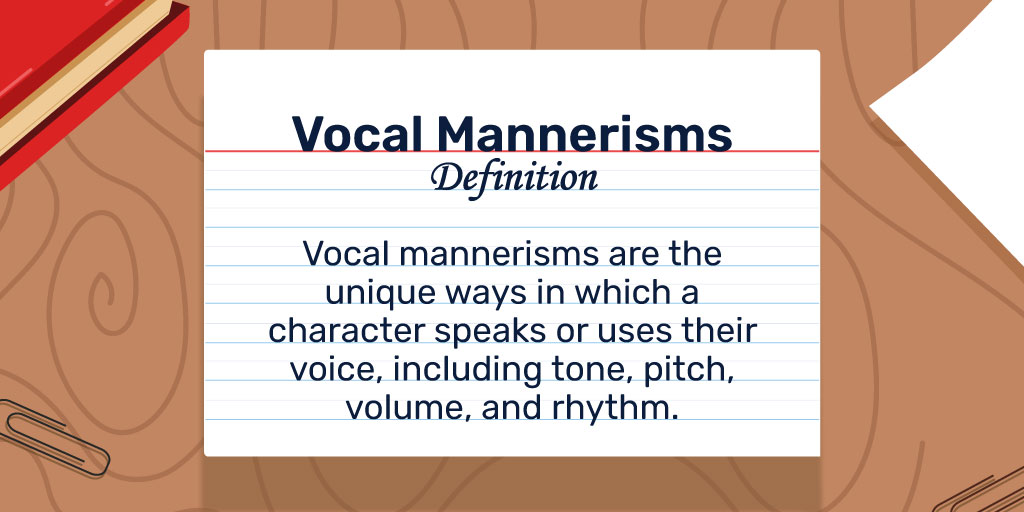
Tone and Pitch
- Bored or apathetic tone
- Breathy or husky tone
- Commanding or authoritative tone
- Crisp, enunciated speech
- Expressive and animated tone
- Flat and emotionless tone
- Gruff or gravelly voice
- High-pitched or squeaky voice
- Low, deep voice
- Melodic or sing-song voice
- Nasal tone
- Rapid or frenzied tone
- Raspy voice
- Sarcastic or mocking tone
- Soft or gentle tone
- Speaking in a monotone
- Speaking with a shaky or quivering voice
- Threatening or menacing tone
- Using a clipped or curt tone
- Using an upward inflection at the end of sentences
- Whiny voice
Voice Volume
- Matching volume to the environment
- Mumbling
- Projecting voice
- Raising voice when excited or angry
- Shouting or yelling
- Speaking at a consistent volume
- Speaking in a loud or booming voice
- Speaking in a soft or quiet voice
- Varying volume for emphasis
- Whispering or speaking in a hushed tone
Speed and Rhythm
- Drawing out certain words
- Pausing frequently or speaking hesitatingly
- Repeating words or phrases
- Speaking at a deliberate or measured tempo
- Speaking in a flowing or melodious rhythm
- Speaking in a halting or uneven rhythm
- Speaking in a relaxed or laid-back tempo
- Speaking in a rapid-fire or machine-gun style
- Speaking in a staccato or choppy rhythm
- Speaking in bursts
- Speaking slowly and deliberately
- Speaking rapidly
- Speaking without pauses
- Varying speed for effect
Accent and Dialect
- African American Vernacular English
- Appalachian dialect
- Australian accent
- British accent
- Cajun dialect
- Cockney accent
- French accent
- Indian accent
- Irish brogue
- Jamaican accent
- Midwestern accent
- New York accent
- Scouse dialect
- Scottish burr
- South African accent
- Southern drawl
- Texan twang
- The use of regional slang or colloquialisms
Education and Social Status
- Sharing oddball sayings
- Mispronouncing or stumbling over certain words
- Mixing words from different languages or dialects
- Speaking with a formal or academic vocabulary
- Speaking with a working-class or informal vocabulary
- Using clichés or catchphrases
- Using euphemisms or polite language
- Using jargon or technical terms
- Using metaphors or similes
- Using profanity
Pauses and Filler Words and Sounds
- Clearing the throat before speaking
- Ending sentences with “Okay?” or “You know?”
- Filling silence with small talk
- Hesitating before speaking
- Inserting laughter between words
- Long pauses for dramatic effect
- Overusing “like”
- Overuse of “um” or “uh”
- Pausing before answering
- Pausing to collect thoughts
- Repeating words or phrases
- Starting sentences with “so” or “anyway”
- Stuttering on certain words
- Using “well” as a filler
- Using “right” as a filler
- Using short, sharp pauses for emphasis
- Utilizing silence as a form of communication
- Whistling often
Laughter and Chuckles
- Awkward laughter
- Belly laughs
- Cackling
- Chuckling
- Contagious laughter
- Forced laughter
- Giggling
- Guffawing
- Hysterical laughter
- Laughing at inappropriate moments
- Laughing in short bursts
- Laughing through the nose
- Laughing with a distinct sound or pitch
- Loud and boisterous laughter
- Nervous laughter
- Sarcastic or mocking laughter
- Silent laughter with shaking shoulders
- Snickering or sneering
- Snorting while laughing
- Suppressing laughter with a hand over the mouth
- Whistling laugh
Speech Impediments
- Cluttering (disorganized speech)
- Difficulty pronouncing certain sounds
- Lisping
- Slurring words
- Mumbling
- Nasal speech
- Over-enunciating words
- Prolonging certain sounds
- Pronouncing “r” as “w”
- Skipping or swapping syllables in words
- Speaking with clenched teeth
- Stuttering
Behavioral Mannerisms
Behavioral mannerisms refer to the patterns of behavior, idiosyncrasies, or rituals that characters display from day to day. These mannerisms involve their interactions with other people or objects in their surroundings, as opposed to the movements of their own bodies.
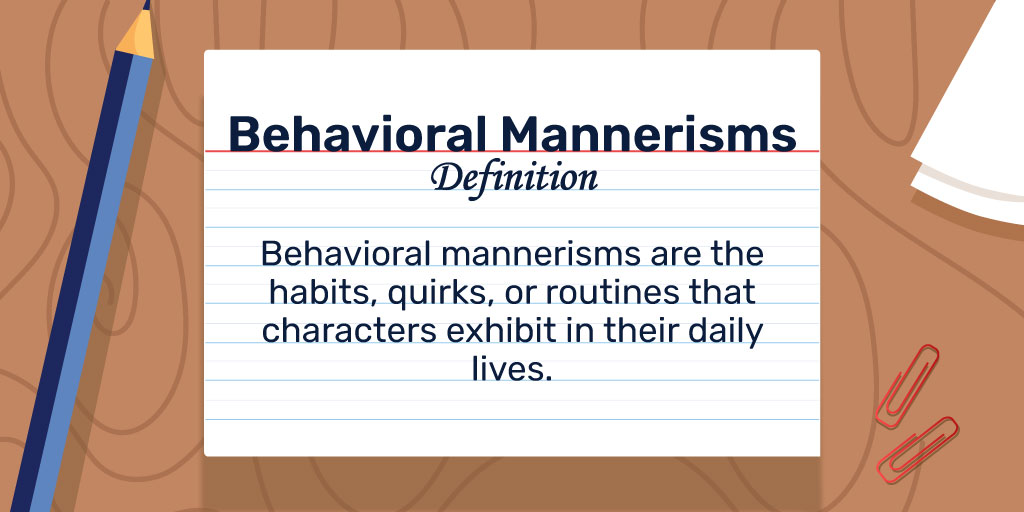
Fidgeting with Nearby Objects
- Adjusting or pushing up glasses
- Bending paper clips
- Buttoning and unbuttoning coat
- Checking phone obsessively
- Checking watch repeatedly
- Chewing the tip of a pen or pencil
- Clicking or tapping a pen or pencil
- Doodling absentmindedly
- Fiddling with earrings
- Fiddling with paper or documents
- Having a cigarette perpetually dangling out of mouth
- Shredding paper
- Taking glasses off and cleaning them
- Tearing a napkin
- Tugging on clothing
- Twirling or tapping a coin
- Twisting a ring or watch
Appearance and Style
- Accessorizing with jewelry
- Carrying a specific type of bag or backpack
- Coloring and styling hair
- Constantly checking appearance
- Displaying tattoos or piercings
- Frequent fixing of hair
- Hiding inside baggy clothes
- Sporting a beard or mustache
- Touching up and applying makeup
- Tucking in shirt or adjusting clothing
- Using expensive or cheap perfume
- Wearing a particular type of shoe
- Wearing bright red lipstick
- Wearing clothing with quotes and sayings
- Wearing dark or muted colors
- Wearing glasses or sunglasses
- Wearing vivid, loud colors
Routines and Rituals
- Always having a specific food for breakfast or lunch
- Always carrying a specific item in their pocket or bag
- Always taking the same route
- Checking emails or social media first thing in the morning
- Checking locks multiple times
- Following a specific pre-performance or pre-game routine
- Insisting on a certain chair or spot
- Knitting to unwind
- Listening to a specific song for inspiration
- Making a to-do list every morning
- Morning coffee ritual
- Nightly skincare routine
- Organizing workspace before starting tasks
- Praying or meditating daily
- Reading during breaks
- Repeating a mantra or phrase for motivation
- Wearing a specific item for good luck
- Washing hands obsessively
- Writing in a journal daily
Social Interactions
- Always asking questions about others
- Always trying to persuade others
- Avoiding conflict
- Avoiding eye contact
- Being a flustered or awkward conversationalist
- Being brutally honest
- Being dismissive
- Being flirtatious
- Being overly chatty
- Being overly polite
- Constantly apologizing
- Dominating conversations
- Engaging in lots of smooth talking
- Frequently spying on others
- Interrupting others
- Laughing at own jokes
- Making flattering comments about others
- Making jokes or puns
- Making lots of critical or judgmental comments
- Making self-deprecating comments
- Often gossiping about others
- Showing affection through touch
- Starting many arguments
- Talking about oneself constantly
- Using lots of sarcasm
- Using nicknames for everyone
Emotional Reactions
- Becoming angry quickly
- Becoming defensive when criticized
- Becoming emotional during arguments
- Blushing or becoming embarrassed quickly
- Crying easily
- Displaying a stoic demeanor
- Expressing emotions through creative outlets
- Expressing wide mood swings
- Holding grudges
- Laughing when nervous
- Overreacting to minor inconveniences
- Refusing to talk about emotions
- Seeking reassurance from others
- Smiling in difficult situations
- Taking things personally
- Using humor when things are hard
Managing Difficult Emotions
- Carrying a gun
- Compulsive shopping
- Deep breathing routines
- Drinking
- Escaping into books, movies, or games
- Exercising excessively
- Isolating oneself
- Listening to calming music
- Meditation or mindfulness practices
- Over- or undereating
- Overworking
- Seeking social support
- Smoking
- Venting to friends
How to Develop Unique Character Mannerisms
While these character mannerisms might be useful to you, you may also want to develop some original ones to help make up your unique characters. Below you will find some strategies for developing mannerisms of your own.
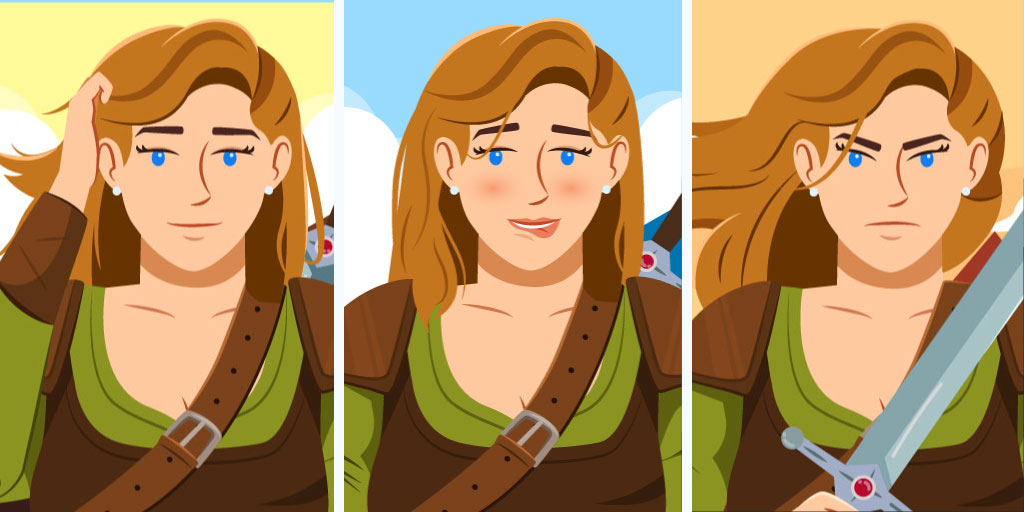
1. Observe Real People
Pay attention to the people around you and take note of their unique mannerisms, habits, and quirks. This can include the way they talk, move, or react to certain situations. These observations can inspire and inform your own character development.
Attend to the little things, those small details that make them unique. Then, since you are creating fictional characters, you can exaggerate those as you wish.
While you are at it, consider the context in which you are observing people. How do their mannerisms change depending on who they’re with, what they’re doing, or where they are? For example, they might be more formal and polite when dealing with clients or customers, but more relaxed and casual around colleagues. It is important to build these differences into your characters to make them more realistic.
2. Consider Personal Experiences
Think about your own experiences and how they have shaped your personality and behavior. Your own mannerisms and habits can serve as a starting point for developing your characters’ mannerisms.
What funny habits do you have that you never think about? How do you react in emotional situations? Do you laugh when you’re nervous or become angry when you’re frustrated? Be honest and build some mannerisms for your characters.
3. Use Character Questionnaires
Character questionnaires can help you to delve deeper into your characters’ personalities and backgrounds, and can provide inspiration for their mannerisms. Ask the following types of questions:
- What is their favorite hobby?
- What is their biggest fear?
- Do they have any superstitions?
- What do they do when they’re nervous?
Think about the questions you would like to ask a person who is becoming your best friend and ask all of those of your characters.
4. Experiment with Physical Movement
Try physically acting out your characters’ mannerisms and movements. This can help you to get into their mindset and embody their unique quirks and habits. For example, you might try walking with a limp or using exaggerated hand gestures.
Adopt your characters’ physical characteristics and act out how they might influence your movements. For example, a character who is short might have a tendency to look up or stand on their tiptoes to appear taller.
5. Consider Personality Traits
Think about your characters’ personality traits and how they might inform their mannerisms.
For example, a character who is confident and outgoing might use expansive hand gestures, one who is shy might avoid eye contact, one who is struggling with anxiety might tap their foot, and one who is highly organized might make lists.
6. Examine Existing Characters
Read widely in different genres and study how other writers develop their characters’ mannerisms. Take note of the techniques they use and the unique quirks they give them.
Pay attention to how the author describes movements, gestures, and speech patterns. Think about how these mannerisms reveal something about the character’s personality. Don’t copy, but rather adapt them to fit your own unique fictional people.
7. Use character arcs
Think about how your characters’ mannerisms might change over the course of the story as they go through arcs.
For example, someone who starts off shy and reserved might become more confident and assertive as the story progresses. As such, a character who initially has a habit of avoiding eye contact might gradually become more confident and begin to hold eye contact for longer periods. Your readers will love having this subtle shift in the character’s mannerisms.
How to Write Mannerisms in a Story
Adding mannerisms to a character can help to make them more realistic and memorable, but it’s important to do so in a way that feels natural and effective for the story. Here we will explore some tips and strategies for incorporating mannerisms into your writing in a way that adds depth to your characters and enhances your storytelling.
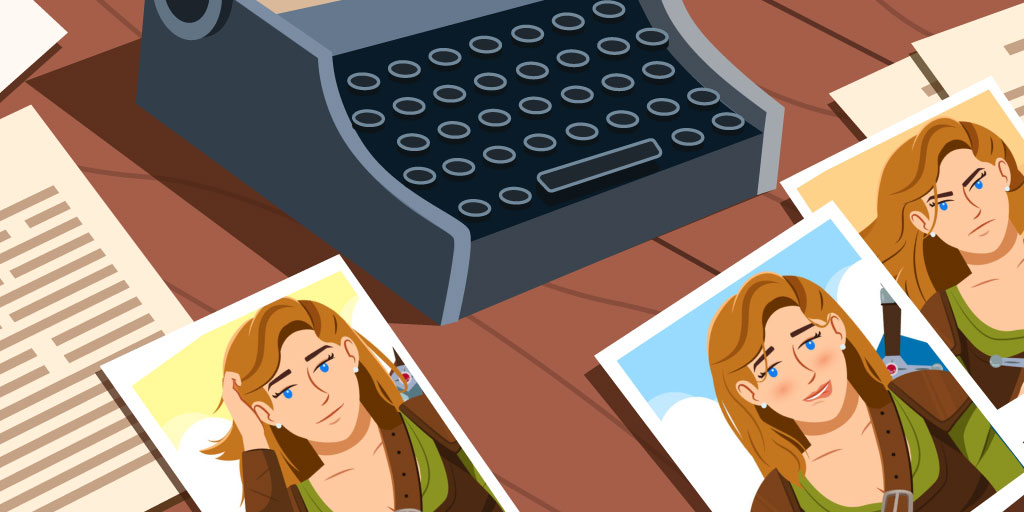
1. Show Don’t Tell
One of the greatest values of character mannerisms is that they help authors obey the golden rule of showing instead of telling. Bring the mannerisms into your story by showing what they are, instead of by describing how your character feels.
For example, instead of saying, “Sarah was impatient because her friend was late,” say: “Sarah drummed her fingers impatiently on the tabletop as she waited for her friend to arrive.” Or instead of writing, “Karen felt threatened and afraid,” rather write, “Despite the heat, Karen couldn’t stop shivering and wrapped her arms around herself protectively”.
2. Story Context Matters
Because the context in which a mannerism appears can shape its meaning and impact in the story, you should use them in a context-appropriate way.
For instance, a character who is nervous will display their mannerism more frequently during a high-stress situation, but less often during a more relaxed scene. Or a character who typically speaks in a soft and gentle voice might raise their voice and pound their fists on the table during a heated argument to emphasize their emotional state and intensity of the situation.
3. Deepen the Character’s Personality
Mannerisms can add depth and nuance to a character’s personality by suggesting hidden or conflicting emotions, thoughts, or motivations. By using mannerisms thoughtfully, writers can reveal the complexity of a character’s personality and emotional life.
A character who is normally composed and in control might, for instance, have a habit of biting their nails or tapping their foot when they’re feeling anxious or uncertain.
4. Show Views & Values
By using mannerisms to show a character’s views and values, you can show the authenticity of their behavior, making them feel like fully-realized individuals rather than flat stereotypes.
A character who is devoutly religious might make the sign of the cross before and after meals, or pause to pray in moments of stress, and one who is passionate about environmental issues might carry a reusable water bottle everywhere they go.
5. Reveal Motivations
Mannerisms can show a character’s motivations by revealing their emotional and psychological state, as well as their underlying desires and goals.
In this way, someone who frequently licks their lips might harbor a subconscious desire for intimacy or sensual pleasure, and someone who frequently checks their watch or taps their foot might be anxious to leave a social gathering.
6. Contrast & Complement Characters
Using mannerisms to contrast and complement characters is a great way to create dynamic and interesting interactions between them in a story.
One way to contrast characters is to give them opposite mannerisms. For example, if one is always tapping their foot impatiently, another might be calm and still. This can create a visual and emotional contrast between them, highlighting their differences and creating tension in their interactions.
On the other hand, complementary mannerisms can create a sense of unity and connection. For example, two characters who both avoid eye contact might feel a sense of mutual understanding and familiarity. This can be used to create a sense of camaraderie or even romance between them.
7. Enhance Dialogues
Instead of writing dictionary English in your dialogues, mannerisms can help you write conversations between your characters that sound more authentic, since they include dialects, interesting vocabularies, interjections, and so forth.
But it goes further than that. Mannerisms can also add emphasis to dialogues, highlighting important points or emotional moments. A character who slams their fist on the table while making a point will add extra weight to their words.
They can also modify the tone and mood of a conversation, setting the emotional atmosphere of the scene. A character who is nervous might fidget with their hands, creating a sense of tension and anxiety.
Character Mannerisms Mistakes & How to Avoid Them
Writing mannerisms can be a powerful way to bring your characters to life, but it’s important to avoid certain mistakes that can detract from their success in your story. Let’s explore some common mistakes and how to avoid them.
Overusing Mannerisms
If you rely too heavily on mannerisms, they can become repetitive and predictable, or, alternatively, confusing, all of which will detract from the story.
To solve this problem, take these steps:
- Consider personality: Choose only two or three key mannerisms for each character that are consistent with their personality and motivations.
- Use sparingly: Use them sparingly, only when they add something to the character or the story.
- Add variety: Use different types of mannerisms, such as physical, vocal, and behavioral, to add variety.
- Choose wisely: Avoid using the same mannerism in every scene or in scenes that are close together.
- Avoid confusion: Don’t introduce too many mannerisms at once, as it can be overwhelming and confusing.
Mismatched Mannerisms
When a character’s mannerisms don’t fit their personality or motivations, it can feel forced or inauthentic.
Consider the following steps to avoid this mistake:
- Match values: When choosing mannerisms for a character, it’s important to ensure that they don’t contradict their beliefs or values.
- Match growth: If your characters grow and change throughout the story, adjust their mannerisms to match their growth.
- Match scene: Choose the right mannerism for the right situation so it is appropriate for the character’s emotions and motivations in the scene.
Stereotypical and Clichéd Mannerisms
Stereotypical and clichéd mannerisms can make a character feel one-dimensional or predictable.
To repair your mannerisms, try the following:
- Human complexity: Keep in mind the full complexity of human existence. Stereotypes are often based on cultural or social assumptions that don’t reflect the full complexity of human behavior.
- Enhance creativity: Draw inspiration from diverse sources such as real people, history, and different cultures.
- Break stereotypes: Think outside the box and change common mannerisms to similar, less common ones.
- Align with character: Connect the mannerisms to the character’s backstory, motivations, and emotions.
Inconsistent Mannerisms
When a character’s mannerisms change without explanation, it can be jarring and disrupt the flow of the story.
The solution is to retain consistency between their emotions and their mannerisms, as follows:
- Introduction early: Introduce the character’s mannerisms early on in the story and make sure they are consistent with their personality and backstory.
- Reflect development: If the character changes during the story, alter their mannerisms gradually and subtly to match their new personality traits.
Final Thoughts
In conclusion, mannerisms can add depth and nuance to a story by revealing a character’s personality, motivations, and values. They can also make them more authentic, believable, and relatable, and supply you with a superb way to show the character’s story instead of telling it. With these considerations in mind, character mannerisms can be a powerful tool to bring your characters and stories to life.
Character Development Quiz (Hard)








